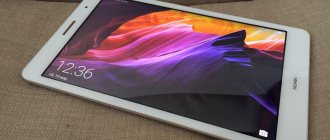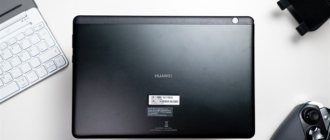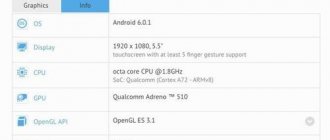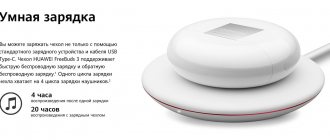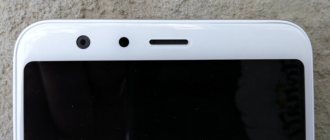The predecessor of this model, the older MEMO Pad Smart 10”, built on the third Tegra and equipped with an IPS matrix with a standard resolution of 1280×800 pixels, was awarded a Best Buy medal by our editors. This tablet pleasantly combined stability, good looks and a low price.
Judging by the technical characteristics of the new MEMO Pad FHD 10, ASUS engineers were tasked with maintaining the result obtained by adding a high-resolution display to it. The device has practically no competitors in this price segment, except perhaps the Huawei MediaPad FHD 10, but it is no longer young, and the price, even though it is in yuan, has not yet dropped to the level of a Taiwanese tablet. Did ASUS manage to realize its plans? We'll find out now.
⇡#Appearance and ergonomics
The exterior of the tablet has remained virtually unchanged compared to the previous model, which, in turn, looks very much like devices from the Eee Pad Transformer line. ASUS designers have created a very attractive case and with each new tablet they improve and refine it a little.
Meet ASUS MEMO Pad 10 FHD
The front panel of the tablet remains unchanged. There are still no buttons on it - all navigation keys are virtual, they are located directly on the screen. Apart from the display itself and the “eye” of the front 1.2 MP camera, there is nothing on it at all. The screen and camera are covered with monolithic glass, which quite well protects the display from scratches and other damage. Unfortunately, there is no oleophobic coating, which is why the panel quickly becomes covered with fingerprints.
ASUS MEMO Pad 10 FHD - front panel
The main difference between the body of the new MEMO Pad 10 FHD is the matte, finely textured back panel. Unlike the glossy one, which was installed in the MEMO Pad Smart 10 (in general, everything is fine in ASUS tablets, but they give them names - you’ll be overwhelmed), it does not collect dirt as actively and retains the presentation of the device much longer. True, dust tends to get into the cells, but it is removed from them very easily. On the back of the device there is a lens for the main, five-megapixel camera and slots for stereo speakers.
ASUS MEMO Pad 10 FHD - back panel and sides
The thickness of the tablet does not reach ten millimeters - this is actually not much, and thanks to the beveled edges the body seems very thin. The arrangement of the elements is quite standard - the MEMO Pad 10 FHD is ergonomically okay.
ASUS MEMO Pad 10 FHD - rear panel
The power button is located on the top end, under the index finger of the left hand. The volume keys are placed on the right side of the case. Next to them is a 3.5mm combo audio jack. The micro-USB interface, micro-HDMI video output, microSD memory card slot and microphone are located on the left side of the device. The bottom edge of the case is empty.
ASUS MEMO Pad 10 FHD comes in three colors - white, dark blue and hot pink
The tablet is assembled quite well - it can withstand pressure on the sides reliably, without creaks or colored stains on the screen. The device turned out to be light - 575 g, thin and cute - the design was definitely a success.
Battery life
The battery in the Asus Memo Pad FHD 10 me302c is quite powerful - 6760 mAh. In fact, the tablet's battery life is quite decent. Testing shows that the device can operate continuously for 5 hours under heavy load, and more than 7 hours when using only Wi-Fi.
Compared to other gadgets in the same price category, these are good results. However, it is inferior to the battery life of the iPad 4 and Nexus 10 (which can last more than 10 hours on a single charge). It is also worth noting that the battery is non-removable, so its subsequent replacement is impossible. This does not affect the repair of Asus Memo Pad FHD 10 if necessary.
⇡#Technical characteristics
| ASUS MEMO Pad 10 FHD (ME302C) | |
| Display | 10.1 inches, 1920×1200 (224 ppi), IPS |
| Touch screen | Capacitive, up to ten points, without the ability to work with gloves |
| Air gap | Eat |
| Oleophobic coating | Absent |
| Polarizing filter | Absent |
| CPU | Intel Atom Z2560: two computing cores, x86 architecture, frequency 1.6 GHz; 32 nm process technology |
| Graphics controller | PowerVR SGX 544 MP2, 400 MHz |
| RAM | 2048 MB LPDDR2-1066 |
| Flash memory | 16/32 GB + MicroSD |
| Ports | 1 x MicroSD 1 x Micro-HDMI 1 x Micro-USB 2.0 1 x 3.5 mm audio jack |
| cellular | No built-in modem |
| IR port | Absent |
| Bluetooth | 4.0 |
| WiFi | 802.11b/g/n |
| GPS | Eat |
| NFC | Absent |
| Sensors | Accelerometer/gyroscope, light sensor |
| Main camera | 5.0 MP (2592×1944), with autofocus, no flash |
| Front-camera | 1.2 MP (1280×960), without autofocus |
| Nutrition | Non-removable battery, capacity 25.5 Wh (6887 mAh, 3.7 V) |
| Size | 265x182x10 mm |
| Weight | 575 g |
| operating system | Android 4.2.2 Jelly Bean |
| Official manufacturer's warranty | 12 months |
| Average retail price | 13,990 rubles |
ASUS MEMO Pad 10 FHD - information about the system and hardware of the tablet
Review of ASUS Memo Pad FHD10 (ME302C)
Android tablets and smartphones based on Intel Atom processors in the “System on a Chip” format began their cautious, almost waltzing, march not so long ago. This summer we were convinced of the viability of combining the x86 system and Android using the examples of ASUS Fonepad and Prestigio Multiphone PAP5430. Both are based on the Intel Atom Z2420, codenamed Lexington. But the hero of this review, the ten-inch tablet ASUS Memo Pad FHD10, turned out to be the first gadget in the gg editors (unless, of course, they missed something) on the Clover Trail+ platform. The dual-core Intel Atom Z2560 processor has a frequency of 1.6 GHz. In addition to the special processor, the second generation of Memopad can boast a FullHD matrix and an adequate price. So, for the 16 GB version of the ME302C in Ukraine they will ask about 3,099 hryvnia (12,400 rubles), and for the same tablet, but with a 32 GB drive, you need to pay 400 hryvnia (that is, 1,600 rubles) more.
Specifications
| ASUS Memo Pad FHD10 | |
| Display | 10.1 inches, 1920×1200 pixels (~224 ppi), IPS, ten-finger multi-touch |
| operating system | Android 4.2.2 JellyBean |
| CPU | dual-core Intel Intel Atom Z2560, 1.6 GHz |
| RAM | 2 GB |
| Graphic arts | PowerVR SGX 544MP2 |
| Storage device | 16 or 32 GB + microSD memory cards |
| Camera | 5 MP, video 1080p; front 1.2 MP |
| Communications | IEEE 802.11b/g/n, Bluetooth 3.0 |
| Connectors | 3.5 mm audio jack, MicroUSB, MicroHDMI, microSD card reader |
| Battery | lithium polymer, 4000 mAh |
| Dimensions | 265x182x9.5 mm |
| Weight | 570 g |
Construction and design
I don’t know about you, but all ten-inch ASUS tablets remind me of the upper halves of laptops, sort of potential or actual “transformers”. And all because of the slightly beveled edges, which give the “back” of the device a visual roundness. The second feature of this tablet and many of its brethren is practicality. Corrugated plastic does not collect fingerprints, does not slip out of your hands, is easily wiped off from dirt and dust and does not lose its appearance when carrying the device without a case. It is probably possible to scratch the back of the Memo Pad FHD10, but this requires a lot of effort or special talent in this area. The color of the rear... Let's call it dark blue-violet, which increases the already overwhelming practicality of the tablet. In addition to this color scheme, there are “marshmallow” options. I mean, white and pink.
Stereo speakers are visible on the sides at the back. The fact that they exist is good, but the choice of location is not the best: if you place the tablet on a level table, you may not be able to completely block them, but on an uneven table, you can easily, just like with a hand grip.
Next to the right speaker, closer to the front surface, there is an audio jack and volume control, and on the left side there is room for two connectors with a micro prefix: USB for connecting to a PC or charger and HDMI for transferring data to an external display. A card reader also fits here, and also with a micro (microSD) attachment.
The top edge is home to the power button and a microphone hole (another one can be seen on the left side). In my opinion, all the connectors are located very well and logically. The buttons are easy to press, but not to the point of constant false positives. It is more convenient to work with Memo Pad with two hands, which is natural for ten-inch tablets. The weight of 570 grams seemed normal for such a device. The body is well assembled, nothing superfluous, no bends or creaks.
In front there is only a screen, a fairly thick frame and a camera. No buttons or frills.
Display
The display is made using IPS technology, its diagonal is ten inches, and the resolution is 1920x1200 pixels, that is, FullHD with a small appendage for on-screen buttons. The glass covering the screen may protect it from scratches, but not very much from glare: in bright sun, even not direct, on the surface of the screen you can contemplate the play of light, shadow and rays in parallel with Android windows, games or movies. This moment and not the highest maximum brightness of the screen (the excellent Outdoor mode bypassed the Memo Pad, maximum 297 cd/m²) make it clear that you can’t lie on the beach with a tablet: it’s better in the shade or in a room.
It is in the shade or room that it will be easier to appreciate the advantages of the screen: a good oleophobic coating (although fingerprints remain, they are easier to erase than with most other devices), pleasant unobtrusive colors, wide viewing angles, close to the correct color temperature. Look at the graph below: in default mode, the colors are slightly warmer than the canonical 6500K. However, if you gravitate towards cooler or warmer colors, the ASUS Splendid app will help you.
The color balance of the device is good, the gamma is somewhat narrower than RGB. The sensitivity of the sensor is very good; touches of all ten fingers will be recognized simultaneously. The light sensor sometimes worked strangely, and suddenly set the screen brightness to minimum for no known reason.
Camera
I know very few people who are willing to use a tablet, especially a ten-inch one, as a camera. However, since manufacturers put two cameras in them over and over again, it means that this is in demand by someone other than technology testers like us. So, the main camera. ASUS Memo Pad FHD10 has a five-megapixel module without frills, like a flash. Judging by the results, the camera is simple, the pictures are quite noisy. However, it is quite possible to capture the information you need in normal lighting, even at close range, and this is where the camera can come in handy. The 1.3 MP front camera copes with Skype, and you don’t need more from it.
System and performance
Android 4.2.2 used here is traditional for the manufacturer. It differs from the standard one by the presence of an additional button for calling widgets and a quick settings panel, where you can turn WiFi on/off, configure energy saving, sound, etc. In my opinion, it’s a convenient shell, and, unlike many other manufacturers, there are normal proprietary applications, like ASUS Splendid for setting up the screen or Wizard, which helps set up the sound. By the way, it’s not bad here, it’s quite loud and clear, but it’s completely flat, without bass. It's better to connect headphones, especially since during games I accidentally blocked the stereo speakers with my fingers, and I think I'm not the only person with a similar arrangement of the upper limbs. Another nice feature is the customization of profiles, for example “work” or “entertainment” and so on, up to seven pieces. In each of them, configure widgets, desktop, wallpaper, switching between them with a slight movement. We determined the performance of one of the first tablets based on the Intel Atom Z2560 single-chip system (Clover Trail+) by watching videos, running tests and games. For some reason, the system was the worst at watching movies by default: the “native” player ignored many formats, and there were problems with sound. After installing MP Player, the situation improved, but I had to enable software playback: in this case, there was normal sound and a non-stuttering picture, even in the case of FullHD video. The new Memo Pad copes well with toys. At least Real Racing 3, Fast Racing and Dead Trigger failed to put it to shame, and the AnTuTu Benchmark test gave 18059 points, which is quite good and significantly loses only to the modern Tegra 4. In GPU tests, the tablet performed well: for example, At maximum quality in the Epic Citadel test, the result was a little more than 30 fps, that is, the device can fully withstand heavy modern games.
Autonomy and heating
The tablet heats up very little, even while running tests or playing games. At maximum screen brightness, the tablet played FullHD movies for 5 hours, and you can play for about 4 hours straight. At average brightness with periodic reading of Internet pages, the Memo Pad can work for about 10 hours. Thus, autonomy is traditional for a ten-inch tablet; I would like more from an energy-saving platform!
Bottom line
ASUS Memo Pad FHD10 creates a good impression of a home tablet that can be used to watch movies, read, and play games without the fear of running out of memory or performance, but without overpaying for the brand and design. It is convenient and unpretentious in everyday life. The screen in it is good, but you should remember: not for open sunny places. It seemed to me that it really lacks connectors for connecting a keyboard; it would turn out to be a budget “transformer”, a sort of modern city netbook with good battery life, a decent screen and performance. By the way, good news for those who, for one reason or another, do not trust the Intel platform: in September, a modification of the ten-inch Memo Pad is expected, the ME302KL model, equipped with a fast Qualcomm 600, and even an LTE modem to boot. In general, given the excellent price/quality ratio, we can safely recommend the tablet for purchase.
4 reasons to buy ASUS Memo Pad FHD10 (ME302C):
- Practical and well-built body;
- good performance;
- Full HD screen;
- affordable price.
1 reason not to buy ASUS Memo Pad FHD10 (ME302C):
- Not for outdoor use: the screen fades in the sun.
⇡#Options
ASUS MEMO Pad 10 FHD - factory box
The tablet's standard package is extremely modest, which, given its class, is not at all surprising. In the box we found the following accessories:
- Quick user guide;
- 2 A charger with USB connector;
- USB ↔ microUSB data cable.
Communications, connections and GPS
Asus Memo Pad FHD 10 FHD supports Wi-Fi 802.11 B/G/N with a maximum speed of 150 megabits per second. The range of use of Fritzbox LTE is quite wide, allowing Full HD video streaming over a distance of more than 20 meters.
The tablet supports Bluetooth 3.0. In addition, the available set of functions allows you to connect the device to a TV without cables via Miracast/Wi-Fi Direct.
In addition to GPS, electronic positioning like a compass is also available. GPS localization takes quite a long time - up to 30 seconds, and the result is sometimes mediocre (low accuracy of determination). This function takes even longer indoors and produces more errors accordingly. Therefore, location should be determined using Asus Memo Pad FHD 10 FHD me302kl only in open areas.
⇡#Display
One of the main advantages of the tablet is its large and beautiful ten-inch IPS screen with a resolution of 1920×1200 pixels. Whatever you say, Full HD (in fact, in this case WUXGA - 16:10 screen aspect ratio) in mid-price devices is still a rare phenomenon. The resulting pixel density exceeds 224 ppi - slightly less than the latest Apple tablet, but noticeably more than its classmates. The “ladder” of pixels can only be seen if you bring the device close to your eyes, although in this case it will be somewhat inconvenient to use. In other words, even a skeptical person will hardly notice individual dots when examining the tablet at the distance at which it is usually held in everyday life.
In-plane switching technology provides the screen with excellent viewing angles, reaching 180°. The information on the display is not subject to any color distortion, even if you look away from the perpendicular. The tablet understands up to ten simultaneous touches and skillfully recognizes gestures.
ASUS MEMO Pad 10 FHD - AnTuTu MultiTouch Test results
The maximum brightness of the ASUS MEMO Pad 10 FHD display is 233 cd/m2. Not as much as I would like. The minimum luminosity of the white field is 22 cd/m2, which means you can use the tablet in complete darkness without disturbing your eyes with an overly bright image.
The black field luminosity reaches 0.36 cd/m2, which is not very much (in this case, less is better). Thanks to this, dark areas in the image remain deep even at the maximum backlight level. The contrast is 635:1 - not the ultimate dream (ASUS Transformer Prime, for example, is almost twice as high), but for an inexpensive tablet it’s quite good.
It's nice that the ASUS MEMO Pad 10 FHD screen is configured almost perfectly. For the eight measured shades of gray, the color temperature varied from 6450 to 6600 K, with a reference value of 6500 K. The picture is warm, lamp-like, and naturalistic.
The tablet comes pre-installed with the ASUS Splendid application, which allows you to adjust the color temperature and saturation of halftones. True, using it only spoils the proper calibration of the display. But the very fact of having such settings is pleasant.
ASUS MEMO Pad 10 FHD - screen color settings
The gray scale gamma curve practically coincides with the standard in the lower and middle parts, but at the top it is slightly raised. This means that bright colors are somewhat overexposed. This was probably done intentionally to make the tree background look more impressive. The gamma curves of the color components are close to ideal, which guarantees the “correct” colors. This makes watching movies on the MEMO Pad 10 FHD a very enjoyable experience.
The color gamut of the tablet screen is noticeably narrower than the sRGB palette - and this is perhaps the only serious drawback of the display. However, the average user won’t even notice this, but otherwise the MEMO Pad 10 FHD matrix is very good.
ASUS MEMO Pad 10 FHD - tablet screen color gamut (black triangle) compared to sRGB color space (white triangle)
Final conclusions
The most striking feature of the Asus Memo Pad FHD 10, for which reviews appeared immediately, is the new screen with a resolution of 1920x1200 pixels. Thus, the tablet successfully competes with many devices released recently. However, it is more expensive due to the addition of a virtual keyboard.
However, the screen displays slightly dull colors and a slight bluish tint, but the resolution and brightness make up for this. Excellent contrast when viewing a darkened image pleases the eye and allows you to watch movies with night scenes. The low temperature of the tablet is also noteworthy. The device remains pleasantly cool even when under load, and is very comfortable to hold thanks to the ribbed back surface.
⇡#Sound
Like the previous model, the MEMO Pad 10 FHD has stereo speakers, which is still rare even for more expensive tablets. The official ASUS website again talks about the mysterious exclusive SonicMaster technology, which makes ordinary tablet tweeters so magical. Indeed, the built-in speakers have a very decent volume reserve - the tablet can be heard even on the street - and good sound detail. Low frequencies do not wheeze, and high frequencies practically do not squeak; Musical compositions are reproduced quite accurately. At maximum volume, the back cover stopped vibrating - the effect of the built-in “mini-subwoofer” disappeared, which, in general, is also good.
ASUS MEMO Pad 10 FHD - AudioWizard settings
The system has pre-installed switchable filters that “adjust” the sound to the content being played - a slightly peculiar equalizer without the ability to manually configure with five built-in presets: “Music”, “Movies”, “Recording” (probably meant “Live/Concert Sound” ), "Games" and "Speech". They are accessed either from the menu or from the notification panel, although they are of little use.
⇡#Performance and hardware
The tablet is built on the increasingly popular Intel Clover Trail+ platform, which we have already become familiar with using the Lenovo IdeaPhone K900 as an example. Unlike the latter, the MEMO Pad 10 FHD is equipped with the average performance chip of the three available in the line - Atom Z2560. The processor has two computing cores operating at a frequency of 1.6 GHz. The Z2560 has 56 KB of L1 cache (32 KB for instructions, 24 KB for data) and 1024 KB of L2 cache. The chip was produced using a 32 nm process technology - not very good, given the presence of a lot of 28 nm ARM processors, but in general it’s quite normal, and for an inexpensive tablet it’s just right. The MemoPad has two gigabytes of RAM - with a reserve - and sixteen built-in, which can be expanded if necessary using MicroSD memory cards.
In the Linpack processor task, the chip showed decent results - approximately 105 million floating point operations per second in a single-threaded test and 217 MFLOPS in a multi-threaded test. True, the Intel processor turned out to be somewhat slower than last year’s older Qualcomm S4 Pro APQ8064, and it is not destined to compete with more modern ARM systems.
During everyday work, the ASUS MEMO Pad 10 FHD practically does not slow down, and there is no talk of any global glitches. The device, like the previous Memopad, demonstrates amazingly stable operation without freezes. The Atom Z2560 quickly renders images for a high-resolution screen - the operating system animation is displayed smoothly. In general synthetic tests, the gadget received good scores (6 thousand points in Quadrant 2 and almost 18 thousand “parrots” in the third AnTuTu Benchmark), but was slightly inferior to the Sony Xperia Tablet Z, running on the already mentioned Qualcomm S4 APQ8064.
The device can smoothly play movies in HD 720p format. Full HD occasionally slows down a little. A standard media player would do well to know more different video containers (most of the video files tested did not play sound). However, installing some MX Player solves this problem.
The ASUS MEMO Pad 10 FHD cannot be called a gaming tablet - the high resolution of the display and not the most efficient system-on-chip affect it. The graphics video accelerator is a dual-core PowerVR SGX544 MP2, capable of operating at a frequency of 400 MHz; iPad 4, for comparison, uses four more powerful SGX554 cores - MP4.
For casual 2D arcade games and not too resource-intensive applications, the tablet’s computing power is enough, but the picture of “heavy” games like Frontline Commando: Normandy sometimes jerks, which is unpleasant. Oddly enough, even the 3D arcade game Minion Crush managed to slow down on the device. Probably, not all Android program developers have optimized their creations for high-resolution screens. However, even in the average complexity of the Basemark 2 Taiji test, the tablet scored only 19.6 FPS - the result, frankly speaking, is not very good. In more complex tasks - 3DMark and Basemark X - the scores are also not at all record-breaking.
3DMark test results | Basemark X test results |
The device copes with web surfing perfectly: with a good connection to the network, it quickly loads pages filled with scripts of varying complexity, smoothly scales them and keeps many open tabs in memory. The SunSpider 1.0.1 browser test, which checks the speed of JavaScript decryption, the device passed relatively quickly (again, taking into account the high resolution) - in 1475 ms.
⇡#Communication
The range of supported wireless modules for the MEMO Pad 10 FHD is limited to blue tooth, Wi-Fi and GPS. The tablet doesn’t have a built-in 3G modem or any not-so-outlandish things like NFC and an infrared port, but budget devices don’t have to have them yet.
Wi-Fi and Bluetooth work flawlessly. Via Bluetooth, data is transferred quite quickly: music tracks are transmitted to wireless speakers without delay. MEMO Pad 10 FHD connects and works seamlessly in both home and public access points. It is noteworthy that data continues to be received at a good speed even when moving away from the source.
Wi-Fi Analyzer test results at a distance of five meters from the router | Speed Test results on a home Wi-Fi network |
The GPS module is responsible for navigation in the tablet, but it works somewhat reluctantly. In ten measurements without Internet access, the gadget found 15-18 satellites per minute, but was oriented only by five or six of them, and the navigation accuracy was not very high. Activating Wi-Fi and connecting to a hotspot does not help the MEMO Pad 10 FHD navigate faster or more accurately.
ASUS MEMO Pad 10 FHD - GPS Test results
⇡#Autonomous work
The tablet runs on a lithium-polymer battery with a capacity of 25.5 Wh (6887 mAh, 3.7 V). For a ten-inch tablet, this is not the largest capacity; on the other hand, under high load, Intel Atom chips are not so power-hungry. In addition, do not forget about the low brightness of the display - this is very helpful in terms of energy saving.
ASUS MEMO Pad 10 FHD - AnTuTu Battery Test Results
In the AnTuTu profile test, the device scored 680 points, discharged at maximum screen brightness from 100% to 19% in 3 hours 18 minutes - a good result. When continuously watching videos with an active Wi-Fi connection and 100% display backlight, the device asked to be charged in just under five hours. In reading mode with minimum brightness and disabled wireless networks, the tablet lasted about twelve hours. Of course, the most energy is spent on the screen backlight: to extend the battery life on a single charge, it is enough to reduce the brightness of the display.
Temperature and impact on device operation
Asus Memo Pad FHD 10 me302kl 16gb is certainly insensitive to small fluctuations in ambient temperature. In standby mode, loading time does not change depending on temperature conditions. The tablet can be placed comfortably on your lap, but you should not let it get hotter than 32 degrees Celsius. The ribbed back surface promotes air penetration and cooling when the device is placed on a solid surface. Intel seems to have good power control. The processor cooling system is more than sufficient, even with continuous active operation of the device for several hours.
⇡#Camera
ASUS MEMO Pad 10 FHD - rear camera
You shouldn’t expect miracles from either the main five-megapixel camera or the front camera with a 1.2 megapixel matrix. The front camera is suitable for video calls and self-portraits only in good lighting, otherwise the picture becomes overgrown with noise. The rear camera is also picky about shooting conditions. Even in daylight, the pictures turn out to be a little noisy - probably for the sake of the sharpness ringing for five megapixels. The color rendition is natural, the picture is moderately rich and contrasting.
Shooting in daylight
When shooting indoors, the picture loses detail and saturation and becomes covered in noise. Often in the resulting photographs you can find gaps in the shadows. In the evening or at night, you won’t be able to shoot with the main camera of the MEMO Pad 10 FHD.
Shooting indoors
The main camera of the device is equipped with an automatic focusing system, thanks to which you can use it to photograph a document or some other text, as well as take macro shots.
Shooting text in moderate lighting
The camera application interface is proprietary, it is slightly different from the standard one for Android. In it you can find a huge number of various settings and effects. There is no need to get into them unless there is an obvious need - the automation does a good job of selecting shooting parameters, except that sometimes it makes a little mistake with the color temperature.
ASUS MEMO Pad 10 FHD - Camera Settings
The tablet can shoot video in high definition format and stitch together panoramas: the picture is stitched together quite neatly, but the image in this mode is very blurred, and the resolution of the final frames is low.
Shooting a panorama
Cameras and multimedia capabilities
The Asus Memo Pad FHD 10 tablet is equipped with two cameras. The rear one has a resolution of 5 megapixels and shows high-quality results in good daylight. The quality of the images is quite acceptable, but the point of using a 10-inch tablet for taking photos is not really obvious. The camera records video in Full HD mode with average quality.
The front camera has a resolution of 1280x800 pixels. Pictures taken with its help are not suitable for an album, but they look good as avatars in mini-resolution and are suitable for social networks and forums. Also, for video calls, the picture quality is quite good.
⇡#Software
ASUS MEMO Pad 10 FHD - lock screen
The tablet runs on Android 4.2.2 Jelly Bean operating system. If any of our readers have not yet had time to familiarize themselves with the new features of the update, you can do so on this page. For example, one of the innovations of the system is the ability to add widgets to the lock screen, which is very convenient.
Notification panel | Settings menu |
Traditionally, the OS has been noticeably recolored by the manufacturer, but in essence it is still the same easily recognizable Android - the logic of the arrangement of elements has remained unchanged. “Launcher” from ASUS is one of the lightest, not overloaded with useless decorations, but at the same time very nice and, perhaps most importantly, fast. The firmware is debugged to an A+ level - in normal mode the device does not slow down at all.
ASUS MEMO Pad 10 FHD - desktops
The user has access to five desktops with the ability to install widgets and sort applications into thematic folders. ASUS offers to use its branded live wallpapers as background images. The tablet comes pre-installed with a lot of useful third-party software, such as the ASTRO file manager, the BuddyBuzz social networking client, a demo version of the famous McAfee antivirus and other programs. ASUS branded applications stand out - there are a lot of them in the tablet, which is very nice. There are programs for backing up data, all kinds of drawing pads, and even software for creating slide shows.
